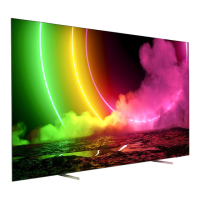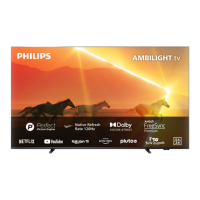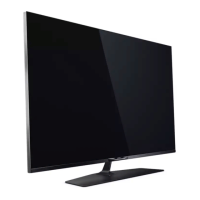Do you have a question about the Philips 55OLED708 and is the answer not in the manual?
Explains the process to protect the OLED screen and ensure proper refreshing.
Provides recommendations to prevent image retention and burn-in on OLED displays.
An overview of the Google TV home screen and its features for content discovery.
Explains the dashboard panel for accessing settings, controls, and notifications.
Compares Google TV and Basic modes, highlighting differences in features and user experience.
Emphasizes reading safety instructions before using the TV.
Details on installing the TV stand or mounting it on a wall.
Guidance on optimal TV placement for viewing and Ambilight effect.
Instructions for connecting and handling the TV's power cable.
Identifies and explains the functions of buttons on the Type 1 remote control.
Explains how to switch the TV on, put it in standby, or reboot it.
Describes how to operate the TV using its physical buttons when the remote is unavailable.
Comprehensive guide to installing satellite channels, including Unicable systems.
Instructions for manually updating TV channels via satellite or antenna.
Advanced guide for manually installing channels from a transponder.
Covers updating channels for antenna reception and related troubleshooting.
Explains DVB settings, channel conflicts, network frequency, and factory reset.
Explains the purpose and conditions for copying channel lists between TVs.
Steps for uploading a channel list to an uninstalled or installed TV.
General information and instructions for installing channels.
Explains how channel lists are organized, icons, and radio stations.
Instructions on how to open and search for channels within a list.
How to lock/unlock channels and set parental controls for age-rated content.
How to set preferred subtitle and audio languages for programs.
Features for users with hearing or visual impairments.
Configuring settings for HbbTV and operator apps.
Instructions for setting up CI+ modules and smart cards for premium channels.
Explains collecting and organizing favorite channels into lists.
Adding, renaming, removing, and reordering favorite channel lists.
How to open, close, and navigate text/teletext pages.
How to open, navigate, and close interactive TV pages.
Instructions for opening, tuning, viewing details, and changing days in the TV Guide.
How to search for programs by genre within the TV Guide.
General advice on connecting devices for optimal picture and sound quality.
Information on HDMI port quality, cable types, and audio return channels.
How to enable and use EasyLink for controlling HDMI CEC compatible devices.
Using the optical audio out connection for sound.
Setting PIN codes for CAM modules.
Connecting a Blu-ray disc player using HDMI and EasyLink.
Connecting digital cameras via USB to view photos.
Connecting camcorders via HDMI.
Connecting a computer via HDMI to use the TV as a PC monitor.
Connecting the TV to a home network for full capabilities.
Steps for establishing a wireless or wired network connection.
How to launch and use the TV's built-in internet browser.
Switching between connected devices and TV tuners.
Overview of the picture settings menu and navigation.
Selecting preset picture styles for different viewing experiences.
Adjusting picture settings using Artificial Intelligence and auto detection.
Adjusting colour settings, including saturation and temperature.
Adjusting picture sharpness and texture enhancement.
Reducing noise and video artefacts for clearer images.
Adjusting motion settings for smoother video playback.
Automatically setting picture styles based on detected content.
Adjusting picture aspect ratio to fill the screen.
Settings to protect the OLED screen from image retention.
Selecting preset sound styles for different audio content.
Optimizing sound reproduction based on TV placement.
Setting up DTS Play-Fi for wireless surround sound.
Adapting audio signal in real time to user's hearing ability.
Selecting preferred surround sound effects and sound styles.
Adjusting DRC, height speakers, and sound stage settings.
Calibrating TV speakers for optimal room acoustics and adjusting volume.
Setting TV sound output to speakers or audio systems, and configuring eARC.
Enabling, disabling, and setting Ambilight to follow video or audio dynamics.
Setting Ambilight to follow video or audio dynamics.
Setting custom Ambilight colours and support for team flags.
Setting personal Ambilight colours and using Ambisleep for relaxation.
Overview of apps, Google Play Store, and app installation/uninstallation.
Using Google Play for renting movies, buying music, and playing games.
Steps to start, stop, and manage apps for optimal performance.
Features for users with disabilities, like high contrast text and text-to-speech.
Procedures for updating TV software via internet or USB.
Displaying TV status and legal information regarding open source software.
Configuring USB keyboards and checking internal storage.
Settings for ambient mode screen saver and power management.
Features for casting, system sounds, and child lock settings.
Adjusting settings specific to the shop mode.
Enabling AI picture demo and instructions for restarting the TV.
Pairing and managing Bluetooth devices.
Information about the remote control, including pairing and battery status.
Viewing media files from a computer or NAS on the network.
Adding favorite media and playing files from USB.
Playing video files from USB or network sources.
Viewing 360 photos and adjusting playback options.
Playing music files from USB.
Using the Philips TV Remote App for smartphone control.
Requirements for playing games and connecting gamepads.
Connecting consoles/computers to play games.
Accessing and using the gaming control bar for settings and info.
Overview of Amazon Alexa voice control and its requirements.
Steps to set up and use Alexa for TV control.
Information on the European Energy Label, disposal, and power specifications.
Technical specifications for aerial and satellite reception.
List of available ports, connectivity options, and multimedia support.
Benefits and steps for registering the TV online.
How to access and use the TV's built-in help system.
Running diagnostic tests to check TV condition and troubleshoot issues.
Common problems and solutions for TV, remote control, and picture issues.
Troubleshooting steps for channel installation and picture reception problems.
Troubleshooting common sound issues like no sound or poor quality.
Troubleshooting HDMI connection issues and USB media playback problems.
Accessing online support resources and contact information.
Important safety instructions to prevent electric shock, fire, injury, or damage.
Precautions to prevent TV tip-over and instructions regarding battery handling.
Viewing terms of use, privacy policy, and privacy settings for Smart TV.
Trademarks and licensing for HDMI, HEVC, G-SYNC, and FreeSync technologies.
Trademarks and licensing for Dolby Vision, Atmos, and DTS:X technologies.
General statement about other registered and unregistered trademarks.
Explains the process to protect the OLED screen and ensure proper refreshing.
Provides recommendations to prevent image retention and burn-in on OLED displays.
An overview of the Google TV home screen and its features for content discovery.
Explains the dashboard panel for accessing settings, controls, and notifications.
Compares Google TV and Basic modes, highlighting differences in features and user experience.
Emphasizes reading safety instructions before using the TV.
Details on installing the TV stand or mounting it on a wall.
Guidance on optimal TV placement for viewing and Ambilight effect.
Instructions for connecting and handling the TV's power cable.
Identifies and explains the functions of buttons on the Type 1 remote control.
Explains how to switch the TV on, put it in standby, or reboot it.
Describes how to operate the TV using its physical buttons when the remote is unavailable.
Comprehensive guide to installing satellite channels, including Unicable systems.
Instructions for manually updating TV channels via satellite or antenna.
Advanced guide for manually installing channels from a transponder.
Covers updating channels for antenna reception and related troubleshooting.
Explains DVB settings, channel conflicts, network frequency, and factory reset.
Explains the purpose and conditions for copying channel lists between TVs.
Steps for uploading a channel list to an uninstalled or installed TV.
General information and instructions for installing channels.
Explains how channel lists are organized, icons, and radio stations.
Instructions on how to open and search for channels within a list.
How to lock/unlock channels and set parental controls for age-rated content.
How to set preferred subtitle and audio languages for programs.
Features for users with hearing or visual impairments.
Configuring settings for HbbTV and operator apps.
Instructions for setting up CI+ modules and smart cards for premium channels.
Explains collecting and organizing favorite channels into lists.
Adding, renaming, removing, and reordering favorite channel lists.
How to open, close, and navigate text/teletext pages.
How to open, navigate, and close interactive TV pages.
Instructions for opening, tuning, viewing details, and changing days in the TV Guide.
How to search for programs by genre within the TV Guide.
General advice on connecting devices for optimal picture and sound quality.
Information on HDMI port quality, cable types, and audio return channels.
How to enable and use EasyLink for controlling HDMI CEC compatible devices.
Using the optical audio out connection for sound.
Setting PIN codes for CAM modules.
Connecting a Blu-ray disc player using HDMI and EasyLink.
Connecting digital cameras via USB to view photos.
Connecting camcorders via HDMI.
Connecting a computer via HDMI to use the TV as a PC monitor.
Connecting the TV to a home network for full capabilities.
Steps for establishing a wireless or wired network connection.
How to launch and use the TV's built-in internet browser.
Switching between connected devices and TV tuners.
Overview of the picture settings menu and navigation.
Selecting preset picture styles for different viewing experiences.
Adjusting picture settings using Artificial Intelligence and auto detection.
Adjusting colour settings, including saturation and temperature.
Adjusting picture sharpness and texture enhancement.
Reducing noise and video artefacts for clearer images.
Adjusting motion settings for smoother video playback.
Automatically setting picture styles based on detected content.
Adjusting picture aspect ratio to fill the screen.
Settings to protect the OLED screen from image retention.
Selecting preset sound styles for different audio content.
Optimizing sound reproduction based on TV placement.
Setting up DTS Play-Fi for wireless surround sound.
Adapting audio signal in real time to user's hearing ability.
Selecting preferred surround sound effects and sound styles.
Adjusting DRC, height speakers, and sound stage settings.
Calibrating TV speakers for optimal room acoustics and adjusting volume.
Setting TV sound output to speakers or audio systems, and configuring eARC.
Enabling, disabling, and setting Ambilight to follow video or audio dynamics.
Setting Ambilight to follow video or audio dynamics.
Setting custom Ambilight colours and support for team flags.
Setting personal Ambilight colours and using Ambisleep for relaxation.
Overview of apps, Google Play Store, and app installation/uninstallation.
Using Google Play for renting movies, buying music, and playing games.
Steps to start, stop, and manage apps for optimal performance.
Features for users with disabilities, like high contrast text and text-to-speech.
Procedures for updating TV software via internet or USB.
Displaying TV status and legal information regarding open source software.
Configuring USB keyboards and checking internal storage.
Settings for ambient mode screen saver and power management.
Features for casting, system sounds, and child lock settings.
Adjusting settings specific to the shop mode.
Enabling AI picture demo and instructions for restarting the TV.
Pairing and managing Bluetooth devices.
Information about the remote control, including pairing and battery status.
Viewing media files from a computer or NAS on the network.
Adding favorite media and playing files from USB.
Playing video files from USB or network sources.
Viewing 360 photos and adjusting playback options.
Playing music files from USB.
Using the Philips TV Remote App for smartphone control.
Requirements for playing games and connecting gamepads.
Connecting consoles/computers to play games.
Accessing and using the gaming control bar for settings and info.
Overview of Amazon Alexa voice control and its requirements.
Steps to set up and use Alexa for TV control.
Information on the European Energy Label, disposal, and power specifications.
Technical specifications for aerial and satellite reception.
List of available ports, connectivity options, and multimedia support.
Benefits and steps for registering the TV online.
How to access and use the TV's built-in help system.
Running diagnostic tests to check TV condition and troubleshoot issues.
Common problems and solutions for TV, remote control, and picture issues.
Troubleshooting steps for channel installation and picture reception problems.
Troubleshooting common sound issues like no sound or poor quality.
Troubleshooting HDMI connection issues and USB media playback problems.
Accessing online support resources and contact information.
Important safety instructions to prevent electric shock, fire, injury, or damage.
Precautions to prevent TV tip-over and instructions regarding battery handling.
Viewing terms of use, privacy policy, and privacy settings for Smart TV.
Trademarks and licensing for HDMI, HEVC, G-SYNC, and FreeSync technologies.
Trademarks and licensing for Dolby Vision, Atmos, and DTS:X technologies.
General statement about other registered and unregistered trademarks.
| Display Type | OLED |
|---|---|
| Screen Size | 55 inches |
| Operating System | Android TV |
| Sound Technology | Dolby Atmos |
| Ambilight | 3-sided |
| HDMI Ports | 4 |
| USB Ports | 3 |
| Smart TV | Yes |
| Refresh Rate | 120 Hz |
| Audio Output | 40W |
| Resolution | 4K UHD (3840 x 2160) |
| HDR | HDR10+, Dolby Vision |
| Wi-Fi | 802.11ac |
| Bluetooth | Yes |











